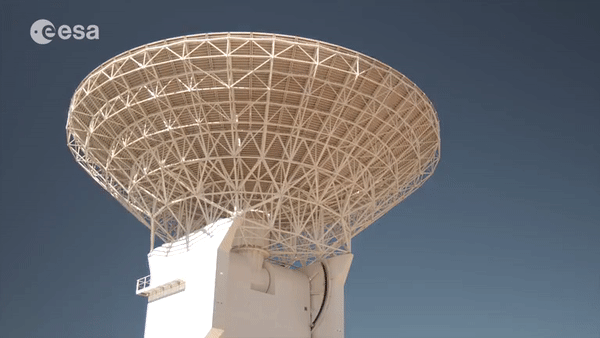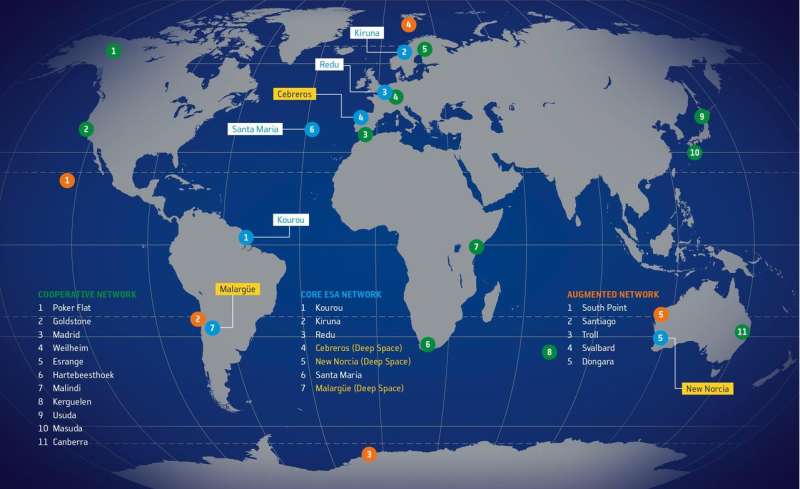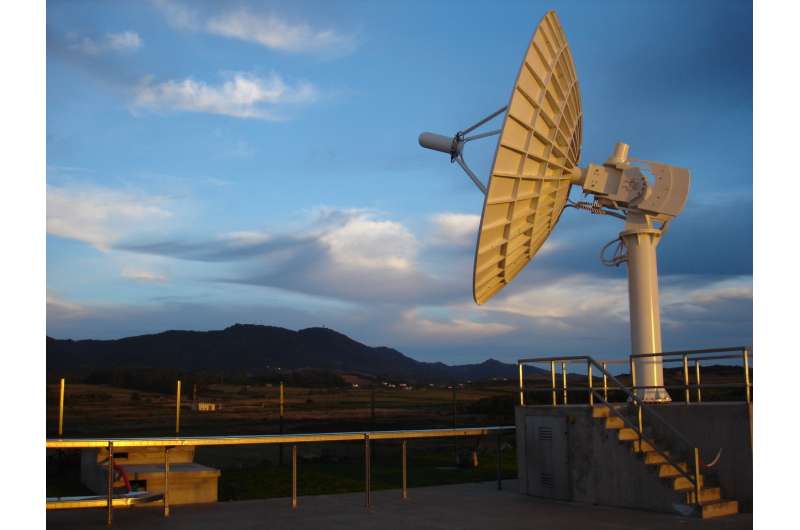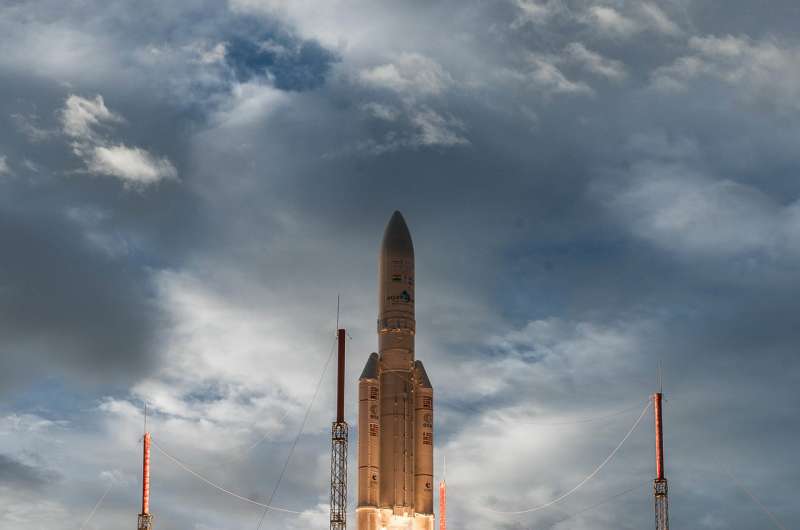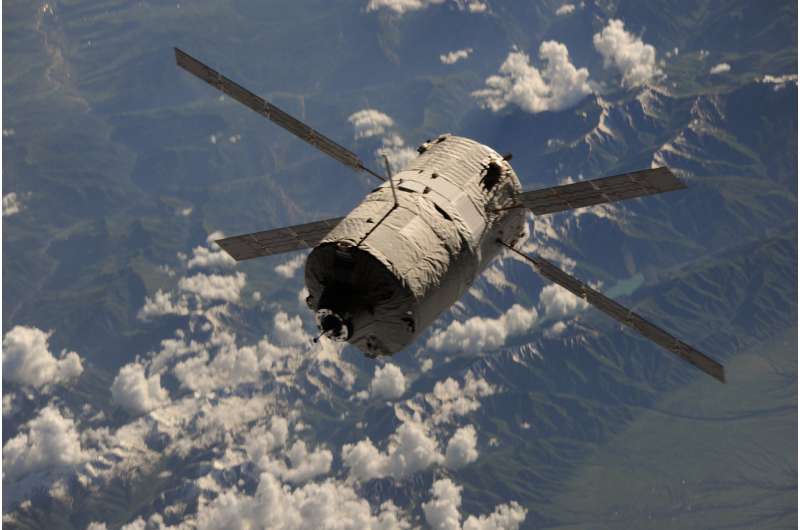A GIF showing ESA's 35m deep-space tracking station at New Norcia, Western Australia, recorded in 2012 when it was was undergoing maintenance. Credit: European Space Agency
As ESA celebrates the 100th launch of Ariane 5, the Agency's worldwide ground station network is also marking ten years of providing vital tracking services to launchers soaring out of Kourou.
ESA's Earth-orbiting satellites and probes out in the Solar System are ultimately dependent on a small network of ground antennas, keeping them connected to their home planet. For ten years, this network has also been doing the same job for Europe's high-flying launchers.
"ESA's ventures into space have sent back vast quantities of scientifically vital data and beautiful images from our Solar System, yet without this little-known network, most of these incredible insights would never have reached Earth." explains Gerhard Billig, responsible for managing launcher tracking support at ESA's operations centre in Germany (ESOC).
Named Estrack, this global system of ground stations provides links between satellites in orbit and the teams on Earth that control them, and of course the scientists who analyse their data.
The core Estrack network comprises seven stations in seven countries on three continents, all are centrally controlled from the Agency's operations centre in Darmstadt, Germany.
Ten years of launcher tracking
Map showing locations of ESA tracking (Estrack) stations as of 2017. Note this map is representational only and not all locations are shown with complete accuracy. Blue indicates core ESA-owned stations operated by the Estrack Network Operations Centre (NOC) located at ESA’s European Space Operations Centre (ESOC), Darmstadt, Germany. Orange indicates Augmented Estrack stations, procured commercially and operated on behalf of ESA by commercial entities. Green indicates Cooperative Estrack stations owned and operated by external agencies, but regularly providing services to ESA missions on an exchange basis. The ESA tracking station at Perth, Australia, was retired from service in December 2015. The ESA stations at Villafranca and Maspalomas, Spain, were transferred to industry in 2017. Credit: European Space Agency
In addition to catching signals from satellites almost anywhere, 2018 marks ten years since Estrack stations began tracking the launch vehicles that deliver these satellites into orbit, starting in March 2008, with the Ariane 5 rocket that carried the ATV-1 cargo vessel, Jules Verne.
Initially established to communicate solely with satellites, Estrack was expanded to support their rockets in 2008 with the establishment of a ground station and 5.5 m-diameter antenna on Santa Maria Island in the Azores archipelago, Portugal. The first Estrack station with the capability to track launchers, Santa Maria provided ESA with the independent means of receiving information from launchers through all phases of their flights.
Santa Maria joined Estrack at the same time that the Automated Transfer Vehicle (ATV)-series of missions got underway; the five ATVs were a series of expendable spacecraft developed by ESA to carry supplies to the International Space Station, at about 400 km altitude.
The special Ariane launch trajectory for these missions required a dedicated station in the middle of the Atlantic Ocean. For the same reason, this station has continued to be used for all launches of Galileo satellites, helping orbit Europe's new navigation system.
In contrast, the original Ariane launcher tracking station network—operated by the French space agency CNES from Europe's Spaceport in Kourou—is tailored for a different launcher trajectory followed by most launches from Kourou. These deliver telecom satellites into geostationary orbit at 36 000 km.
ESA's Santa Maria ground station is located on the ‘Montes das Flores’ (Hill of Flowers) on Santa Maria island in Portugal's mid-Atlantic Azores. It includes a Galileo Sensor Station. Credit: European Space Agency
Santa Maria tracks all launch vehicles operated from Europe's Spaceport: including the three world-changing launch vehicles, Ariane 5, Soyuz and Vega.
Estrack stations provide teams on site with vital information acquired from the launchers soaring overhead, which is then passed on to the CNES and Arianespace teams who control their flights.
"ATV-2 in 2011 was a particularly memorable launch," says Gerhard, who was at Santa Maria station at the time.
"Just minutes after liftoff from Kourou, while the Ariane rocket was in radio contact with our station, we could see it whizzing high over our heads in the clear night-time sky."
"We could actually make out the upper stage thruster burning! It was amazing to see the rocket speed across the horizon, like a comet through the sky. And what we saw visually, was being confirmed on our screens via the live telemetry link."
On 28 June 2017, Ariane 5 flight VA238 lifted off from Europe’s Spaceport in French Guiana and delivered two telecom satellites, Hellas Sat 3–Inmarsat S European Aviation Network and GSAT-17, into their planned orbits. A new four-panel fairing was also validated on this flight. Credit: European Space Agency
To date, the Estrack stations in Portugal and Western Australia have supported 35 launches, many of which were monitored by more than one ground station; 16 launches have been supported from Santa Maria, and 34 from Western Australia (20 from Perth and 14 from New Norcia).
Upgrading down under
In 2010, the existing New Norcia antenna in Perth, Western Australia, was upgraded for launcher tracking.
It was used for tracking not only ATV and Galileo launches but also rockets delivering satellites to 'Sun-synchronous orbits' and onto interplanetary trajectories.
"For a decade now, tracking services for both the launcher and the satellite are provided, a unique and important capability during the first, critical moments of a satellite's mission," says Gerhard.
ATV Albert Einstein, Europe’s supply and support ferry, docked with the International Space Station on 15 June 2013, some ten days after its launch from Europe's Spaceport in French Guiana. In this image, ATV's four solar panel arrays can be seen along with the vertical antenna on top. This antenna is the ‘proximity boom’ that is used to communicate with the station. ATV Albert Einstein brought 7 tonnes of supplies, propellant and experiments to the complex. ESA astronaut Luca Parmitano oversaw the unloading and cataloguing of the cargo, comprising over 1400 individual items. Credit: ESA/NASA
Since the closure of Perth station in 2016, its launcher tracking capability has been transferred to ESA's deep space station at New Norcia, also in Western Australia.
100th Ariane 5 launch
On 25 September 2018, another important milestone was reached for the Agency, as the 100th Ariane 5 rocket was launched into space. To mark this milestone 100th Ariane 5 flight, ESA is releasing 100 limited-edition t-shirts via the ESAshop.
From 26–30 September all ESAshop t-shirts are being sold at a 15% discount with the code "ARIANE5".
Provided by European Space Agency
